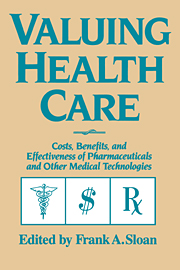 Valuing Health Care
Valuing Health Care Book contents
- Frontmatter
- Contents
- List of Tables
- List of Figures
- List of Boxes
- Acknowledgments
- 1 Introduction
- 2 Evidence of effectiveness: evaluating its quality
- 3 Utility assessment for estimating quality-adjusted life years
- 4 Measuring costs
- 5 From cost–effectiveness ratios to resource allocation: where to draw the line?
- 6 Valuing health care benefits in money terms
- 7 Discounting health effects for medical decisions
- 8 Statistical issues in cost–effectiveness analyses
- 9 Decision trees and Markov models in cost–effectiveness research
- 10 The use of cost–effectiveness/cost–benefit analysis in actual decision making: current status and prospects
- Notes
- References
- Index
3 - Utility assessment for estimating quality-adjusted life years
Published online by Cambridge University Press: 07 December 2009
- Frontmatter
- Contents
- List of Tables
- List of Figures
- List of Boxes
- Acknowledgments
- 1 Introduction
- 2 Evidence of effectiveness: evaluating its quality
- 3 Utility assessment for estimating quality-adjusted life years
- 4 Measuring costs
- 5 From cost–effectiveness ratios to resource allocation: where to draw the line?
- 6 Valuing health care benefits in money terms
- 7 Discounting health effects for medical decisions
- 8 Statistical issues in cost–effectiveness analyses
- 9 Decision trees and Markov models in cost–effectiveness research
- 10 The use of cost–effectiveness/cost–benefit analysis in actual decision making: current status and prospects
- Notes
- References
- Index
Summary
Programs in health care have varying objectives. The objective of prenatal care might be a reduction in infant mortality. Rheumatologists strive to make their patients more functional, whereas primary care providers often focus on shortening the cycle of acute illness. All of these providers are attempting to improve the health of their patients. However, they each measure health in a different way. Comparing the productivity of a rheumatologist with that of a neonatologist may be like comparing apples to oranges.
The diversity of outcomes to health care has led many analysts to focus on the simplest common ground, typically, mortality or life expectancy. Those who are alive are statistically coded as 1, and those who are dead are statistically coded as 0. Mortality allows the comparison between different diseases. For example, we can state the life expectancy of those who will eventually die of heart disease and compare it to the life expectancy of those who eventually die of cancer. The difficulty is that everyone who remains alive is given the same score. A person confined to bed with an irreversible coma is alive and is counted the same as someone who is actively playing volleyball at a picnic. Utility assessment, on the other hand, allows the quantification of levels of wellness on the continuum anchored by death and optimum function.
This chapter reviews the concept of utility in relation to the evaluation of cost–effectiveness of pharmaceutical products.
- Type
- Chapter
- Information
- Valuing Health CareCosts, Benefits, and Effectiveness of Pharmaceuticals and Other Medical Technologies, pp. 31 - 60Publisher: Cambridge University PressPrint publication year: 1995
- 25
- Cited by


